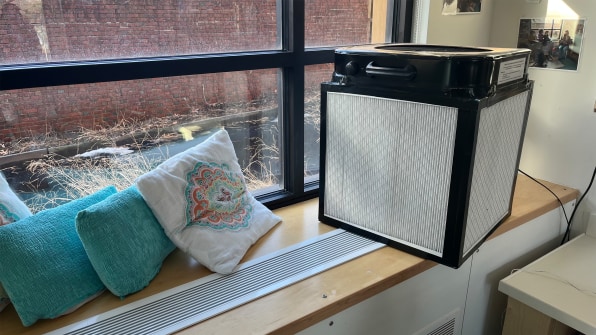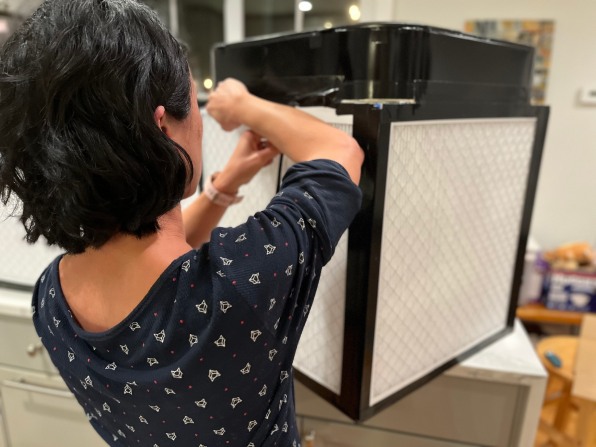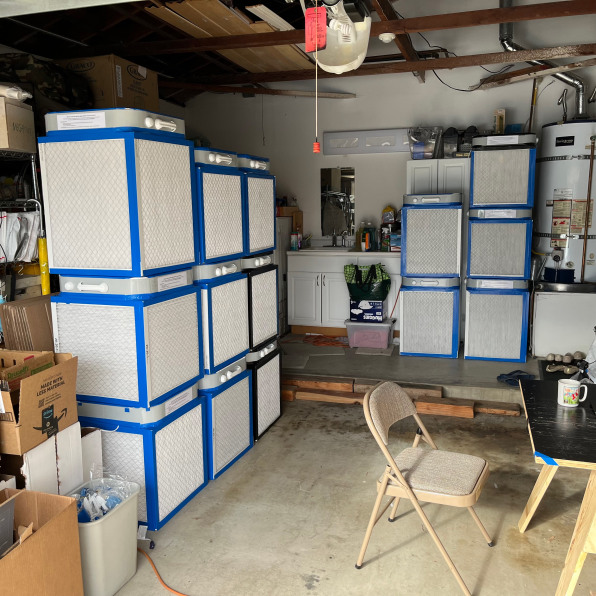Just one afternoon, a dozen Arizona State College pupils gathered to commit the morning chopping cardboard, taping lovers, and assembling filters in an hard work to develop 125 portable air purifiers for local educational institutions. That exact same early morning, team users at a homeless shelter in Los Angeles ended up setting up 20 handmade purifiers of their own, when in Brookline, Massachusetts, a different Do it yourself air purifier was whirring quietly in the back again of a daycare classroom as children performed.
The know-how in all a few cases—an unassuming duct tape-and-cardboard design known as a Corsi-Rosenthal box—is actively playing an significant aspect in the battle towards COVID-19. The tale of how it arrived to be also reveals a lot about communities as sources of innovation and resilience in the confront of disasters.

A basic know-how with a major outcome
As it became crystal clear that COVID-19 was unfold by means of airborne transmission, people today begun donning masks and building managers rushed to enhance their ventilation programs. This usually intended putting in high-efficiency HEPA filters. These filters operate by capturing virus-laden particles: Air is forced into a porous mat, contaminants are filtered out, and clean up air passes by means of.
The efficacy of a building’s ventilation technique is ruled by two factors, however, not just the high quality of the filters. The volume of air moved via the air flow devices issues as nicely. Specialists normally propose five to six air changes for each hour in shared spaces, which means the total volume of air in a place is changed every 45 minutes. Methods in many more mature buildings can not manage this volume, however.
Moveable air filters are an solution for augmenting ventilation techniques, but they typically price hundreds of pounds, which places them out of vary for educational institutions and other general public areas that experience price range constraints.
This is exactly where the Corsi-Rosenthal box arrives in. It is a dice consisting of 4 to five off-the-shelf furnace filters topped by a standard box lover blowing outward. After sealed alongside one another with tape, it can sit on a ground, shelf, or desk. The enthusiast attracts air through the sides of the dice and out the top rated. The models are very simple, long lasting, and quick to make, and are far more powerful than simply just placing a solitary filter in entrance of a box admirer. It normally takes 40 minutes, minimum technological expertise, and $60 to $90 in resources that are out there from any house source retailer.

Irrespective of this simplicity, nevertheless, these home made models are exceptionally powerful. When used in a shared space like a classroom or clinic ward, they can nutritional supplement present ventilation and eliminate airborne contaminants, including smoke and virus-laden particles. A raft of modern peer-reviewed analysis has discovered transportable air purifiers can radically decrease aerosol transmission. Other preprint and under-review scientific tests have observed Corsi-Rosenthal bins conduct as well as experienced units at a fraction of the charge.
Origins of the Corsi-Rosenthal box
The formal tale of the Corsi-Rosenthal box started in August 2020, when Richard Corsi, an air high-quality specialist and now dean at the College of California, Davis, pitched the idea of developing low-cost box-supporter air filters on Twitter. Jim Rosenthal, the CEO of a Texas-based filter business, experienced been enjoying all-around with a comparable idea and rapidly designed the first prototype.
In just days, tinkerers and air excellent engineers alike were being developing their have Corsi-Rosenthal containers and sharing the outcomes on social media. A vivid dialogue emerged on Twitter, mixing sophisticated complex analysis from engineers with the insight and endeavours of nonspecialists.
By December, hundreds of men and women were being earning Corsi-Rosenthal boxes, and countless numbers extra experienced read through push protection in stores like Wired. In unique corners of the planet, men and women tweaked styles based mostly on the availability of materials and distinct wants. Their collective enhancements and diversifications were being documented by dedicated websites and weblogs as nicely as information reviews.
In some circumstances, style tweaks proved to be influential. In November 2020, for instance, a home-owner in North Carolina found an difficulty with air staying drawn back in via the corners of the most frequently employed sq. followers. Subsequent testing by air excellent professionals confirmed that introducing a shroud to the supporter enhanced efficiency by as significantly as 50%.
Examining social media and information coverage gives a perception of the scale of the Corsi-Rosenthal box phenomenon. As of January 2022, a lot more than 1,000 units were in use in universities, with countless numbers extra in homes and workplaces. Far more than 3,500 men and women had utilised the hashtag #corsirosenthalbox on Twitter, and tens of thousands extra contributed to the on-line discussion. News articles or blog posts and explainer movies on YouTube had collectively accrued more than 1.9 million views.
Communities as resources of innovation
The tale of the Corsi-Rosenthal box is element of a broader tale of the grassroots response to the COVID-19 pandemic. The early days of the pandemic did a lot more than just take a horrible toll on men and women. They also galvanized a significant entrepreneurial hard work, with tens of thousands of each day citizens lending their fingers to structure and produce the critical health-related provides and individual protective tools that was instantly necessary.

My study crew has been monitoring these attempts. Through dozens of interviews and months of archival analysis, we’ve built a databases of extra than 200 startups—formal and informal, nonprofit and for-profit—whose activities ranged from developing oxygen concentrators to 3D printing experience shields to developing UV disinfection rooms. The photo of innovation that emerges is a considerably cry from the classic lab coats and center supervisors graphic that is frequently linked with new systems.
1st, few of the innovations we’ve tracked were being really invented by a single person, or even a solitary workforce. Alternatively, they were being the joint project of broad networks of particular person contributors from distinctive backgrounds and businesses. This breadth is critical since it provides extra understanding and extra various views. It can also be beneficial for tapping current know-how. For instance, as Corsi-Rosenthal packing containers obtained traction, the community was in a position to draw on previously iterations that experienced been developed to assist with wildfire smoke.
2nd, the innovation approach lacked hierarchical command. There was no solitary human being directing wherever or how the technological innovation was utilized. This absence of control manufactured it a lot easier to experiment and adapt to community ailments. A single instance is the progress of oxygen concentrators for use in hospitals in India. Recognizing that current Western technologies unsuccessful usually in the a lot more humid operating surroundings standard of India, teams of innovators rallied to develop and share improved open-resource styles.
3rd, these communities shared information on the net. This authorized specific contributors to connect directly and share tips, which helped expertise distribute promptly by the network. It also intended that know-how was far more conveniently accessible. The in-depth types and take a look at outcomes from air high-quality engineers operating on Corsi-Rosenthal packing containers were easily out there to any person in the local community.
Also, most of the companies we tracked used Fb, Twitter and Slack as instruments to regulate collaboration within and amongst businesses. As I and other people have argued, this provides grassroots innovation huge promise—especially in a world where huge-scale disruptions like a pandemic are significantly common.
Pitfalls of grassroots innovation
Irrespective of this guarantee, there are locations in which grassroots innovation communities falter. One problem is a absence of technological sophistication and assets. Although some of the communities in our review generated remarkably sophisticated gadgets, the best contribution was in considerably less complicated goods like experience shields and surgical gowns.
Then there are guidelines and rules. Even when grassroots communities can generate secure and productive innovations, existing policies could not be completely ready to get them. Some hospitals had been unable to acknowledge PPE furnished by the community through the pandemic since of inflexible procurement guidelines, and now some educational institutions continue on to prohibit Corsi-Rosenthal containers.
A final issue is sustaining effort. Although grassroots communities have been important to allowing for hospitals and professional medical amenities to continue to be performing for the duration of the early days of the pandemic, quite a few of the attempts that depended on volunteer labor finally ran out of steam.
What this usually means for the potential
As the 2nd anniversary of the U.S. declaration of unexpected emergency techniques, a essential lesson the entire world has uncovered is the importance of investing in indoor air top quality, for case in point via monitoring and enhanced air flow and filtration. And the price of air flow as a noninvasive public wellbeing software is even larger as mask mandates wane.
Another, broader lesson is the electric power of grassroots innovation and citizen engineering to develop these systems. The story of the Corsi-Rosenthal box, like the thousands of other grassroots improvements designed during the pandemic, is essentially about persons having the welfare of their communities into their individual arms. The most well-known tweet shared about Corsi-Rosenthal packing containers was from a 14-year-outdated aspiring engineer in Ontario presenting to establish and donate boxes to any one in will need.
Douglas Hannah is an assistant professor of technique and innovation at Boston College.
This short article is republished from The Conversation below a Innovative Commons license. Browse the original posting.